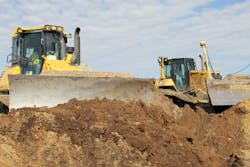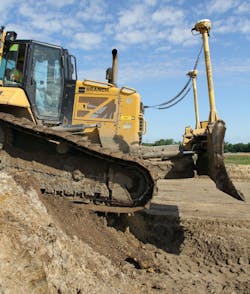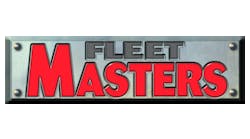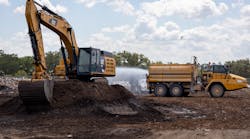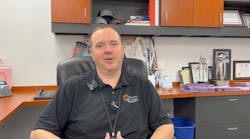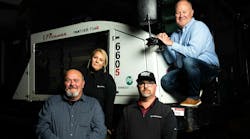If the merger wasn’t a formidable enough task, Branch also decided to implement massive changes to the way it tackles equipment asset management and workforce development.
2019 Fleet Master, Small Fleet
Branch Civil is the small-fleet winner of the 2019 Fleet Masters Award. Large-fleet winner Sarasota County, Florida, is profiled here. The awards are presented by Construction Equipment and the Association of Equipment Management Professionals (AEMP) and are judged on categories such as finance, information management, policies, and controls.
First, it had to examine from within and decide what was most important.
“We had a lot of meetings, and did our best to get input and buy-in from everybody, and made a decision that this is the direction we’re going,” says Tim Morgan, CEM, the company’s equipment operations manager. “We just hammered it out that way. It didn’t always go smoothly, didn’t always go happily, but we made it through.
“We made sure everybody had the opportunity to have their voice heard, and then reached as close to a consensus as we could,” Morgan says.
“A lot of times, both places had to change,” says Patrick Bartorillo, Branch Civil’s president. “Because we looked at what was the best way to do things going forward, and sometimes it was different than what either company was doing.”
One of the first and most visible changes was a highly ambitious technological advancement program.
The program includes GPS tracking with real-time data on 100 percent of its on-road fleet; OEM telematics data accumulation to a single portal for heavy equipment; manual entry for the 40 percent of equipment that is non-telematics equipped; QR code location tracking of all assets and small tools; equipment logistics dispatching and tracking; real-time fuel inventory and dispensing information; and inspections, work orders, hour meter/odometer, and payroll work flows.
“We’re not 100 percent telematics yet,” Morgan says. “Sixty percent of our heavy iron has telematics. For the other 40 percent, we send data in manually. We use iPads and other mobile devices as surrogate telematics for our equipment that doesn’t have telematics. If our technicians come up to a piece of equipment, they can open a box in our program that says ‘I’m standing beside this piece of equipment,’ and they can input data, hours, fuel; whatever they need.”
Branch has elected not to put third-party “black boxes” on equipment that does not have factory-installed telematics. Morgan says they’ll get to the 100 percent objective by attrition. “Our legacy equipment doesn’t provide enough data to warrant the cost of a permanent telematics device,” he says.
Once pieces are connected or data is entered, the biggest goal is to get real-time data into one portal, which is not always easy for a mixed fleet.
“Nothing existed that we felt gave us everything we wanted or needed,” Morgan says. “So we asked a lot of questions and worked with a software developer, Genesis Circle [now marketed by Teletrac Navman], to develop the program we wanted, suited to what we do.”
And so began a giant flow of data covering the bulk of 437 on-road vehicles, 596 pieces of heavy iron, and 1,512 small tools and other assets.
“You go from an equipment manager to a data manager and you have to come up with a solution to filter all the noise to get the action items out of the noise,” says Bill Yeager, P.E., CEM, director of equipment. “You’re inundated with hundreds of codes a day and have to figure out which ones add value; what’s going to cause a machine-down, and what’s a false positive or miss. Is it something that can become a scheduled maintenance item versus ‘Uh oh, what’s going to happen now?’”
Filtering data is one thing, taking the right action as a result of what’s learned is something else. This is where another of the dramatic changes Branch Civil made comes in: the Situational Awareness Room (SAR).
The room, residing in the shop at the company headquarters in Roanoke, features multiple computer stations and three large communal monitors used to facilitate fast-paced, field-level decisions.
“We wanted to be able to combine information from everywhere into a central location to give everybody access to the information, but decentralize command and control over the day-to-day operations in the field to regional areas,” Morgan says.
“That’s where the SAR comes in,” he continues. “It allows us access to real-time data to make quicker, better informed decisions, and to get the information out to the people who need to make those decisions out in the field more quickly and with more accuracy.”
In the field, all technicians and management personnel are outfitted with smartphones and tablets, so information and data can be shared instantly. Technicians, especially, are empowered with the information. They no longer have to wait long periods of time for decisions or instructions.
“We have four different stations in the SAR, a key one is our logistics foreman,” Morgan says. “He’s the leader of the room, watching three monitors. One monitor tracks all of our lowboys, mechanic trucks, and fuel trucks. One is the communication board, and one is the equipment management board.”
Here’s a typical example of a “situation” for the SAR.
A 15-year Legacy
AEMP and Construction Equipment magazine have partnered to highlight the very best construction fleets in the world for the last 15 years.
Our continued focus on honoring the men and women who manage these assets is a crucial part of our thriving equipment management career sector.
The profession is changing at the speed of light through innovation, technology, and improved efficiencies, and the role of these dedicated professionals is being elevated to the highest levels within companies across the industry.
AEMP and Construction Equipment stand together firmly dedicated to ensure these stellar efforts are recognized each year so other fleet teams can learn from exemplary operations.
The Fleet Masters articles and interviews in CE highlight effective fleet-management tactics and strategies that can benefit all equipment managers. This is just one way the Fleet Masters Award will continue to drive the industry forward for years to come.
“Let’s say they get a phone call from an area superintendent or field mechanic who says this piece of equipment is down,” Morgan says. “The phone is only one of the communication options used by the SAR. Telematics usually won’t tell me when a hydraulic hose is getting ready to burst, a machine throws a track, or an operator breaks a tooth or a cutting edge. But the logistics manager can now gather the information he needs right in that room to make a decision.
“First, how critical is it to the job? Does it need to be replaced now, or can the job do without it until it’s fixed?” Morgan says. “Next, are we going to fix it? If we are, where? Do we fix it in the field, fix it in one of our shops, or send it to a dealer shop? And if we elect to have a replacement, the logistics manager has the ability to make phone calls, get a rental in place, and set up the logistics.”
The SAR is able to deal with equipment repairs, equipment requests from individual jobs, and rental requests, as well as the information a technician in the field may need.
Morgan said that although many of the same decisions would need to be made in the two companies prior to the merger, the decisions would involve several different people, and numerous sets of emails and phone calls.
“It has saved money, we’ve reduced our rentals, and made our repairs more efficient and timely,” Morgan says. “We make sure we’re taking our equipment to the right spot, and make sure the right questions are being asked.”
In two years’ time, the company expects a 20-percent reduction in field administrative time, leading to more wrench time for technicians, a 10-percent reduction in technician travel time and mileage due to more efficient dispatching, a 50-percent reduction in office processing time due to more direct input from the field, and a 10-percent reduction in equipment rentals due to more efficient use of its organic fleet.
When Branch needs to expand its fleet, it buys or leases most of its equipment. “It’s situational,” Bartorillo says. “We do lease more than we used to. Our backlog increase has been tremendous, and to keep up with the needs of the production folks, we’ve had to lease more.”
“Perishable technology is another reason we always want to have the latest and greatest in the field,” Yeager says. “If you looked 10 years ago at a vehicle and asked ‘Do you have a half-ton truck with a 400-horsepower V6 that tows 13,000 pounds?’ the reply would be ‘You’re crazy,’ but that’s every day on the road now.
“Technology is changing so fast and I think everybody in the industry sees it,” Yeager says. “It’s hard to get technicians, it’s hard to keep everybody up to speed, but this is our edge—if you can get the technology out of your machines to forecast potential problems, you can outcompete your competitor.”
In the field, that means constantly educating personnel in how to gain an edge with the newest equipment.
“It’s showing what new functions are available to all stakeholders for successful practices to bring them along to adapt to this new technology, not only on the equipment side, but on the production side, for the win,” Yeager says. Branch has purchased a number of the latest-model Komatsu and John Deere crawler dozers with integrated grade control features.
“Integrated [grade control] has been a great addition for safety and cost. People are not falling off of blades and tracks, it’s a lower cost because it’s integrated with the machine from the factory, and you don’t have antennas rolling around being damaged,” Yeager says.
“Also, the resale makes our leases more attractive by pushing the residuals higher, so it’s a win-win,” Yeager says. “There’s the asset side and there’s the operational side. You’ve really got to win on both sides to crush it. If you buy it wrong, you could fix it right, but it isn’t going to make a huge difference. If you buy it right and you fix it wrong, it’s going to be the same outcome. You’re not going to be as successful as having both of them in the right.”
As the company’s footprint and the nature of its inventory has changed, so has its relationship with equipment dealers and the services they provide.
“In implementing telematics, we had to partner very closely with our dealers,” Morgan says. “We use the OEM telematics portals and API them into a single portal reference. And we depended on them to teach us how to use that. But now that we’re growing, instead of being focused on a single dealer, we’re focused on a dealer network.”
Branch has expanded regionally across Virginia and North Carolina and has been setting up programs so it has equivalent processes and pricing across multiple dealers over multiple regions.
“We are becoming more brand sensitive and reducing the number of OEMs involved,” Yeager says. “The brands shared across different areas must be supported by the same OEM, but different dealers [meeting our] same expecations.”
Morgan points out Branch is indeed moving to fewer OEM brands for simplicity, efficiency, and volume pricing, “But we will never sacrifice quality of service for brand loyalty,” he says. “It doesn’t matter what color the equipment is painted if you can’t get service or can’t get parts for it.”
The company places a premium on service.
“Some dealerships are better at some things than others are,” Morgan says. “And in different areas some dealerships are better than others. It’s just the nature of the business. We’ve based relationships with dealers on their ability to service what we need.”
Branch Civil examines dealers closely, and will tailor the brand of equipment for a job based on the strength of area dealerships.
“We’re basically doing a vendor evaluation for each region we’re going to,” Yeager says. “And looking at how strong or weak they are, and we’ll base their category on many things—parts, sales, service, and pricing. We also perform a SWOT analysis on some dealers that we frequent. All that is discussed before we even drop equipment on the ground.
“We might move a particular brand machine here, but we won’t move it there, based on service, sales, parts,” Yeager says. “Some [talents] don’t always go across state lines. Before, we were more area-focused. Now, with a more global, multiregional perspective, we’re able to step back a little bit. A dozer breaks down, so let’s call Johnny at the local dealer. Not now. We’re going to look in their world and ask who’s got a second shift so they can repair it quickly? Who’s slow, where it’s going to sit outside?
“All these decisions are now happening before the machine is even moved to a repair facility,” Yeager says. “Now we’ll know if we can go to someone who’ll work day and night so they can give it a fast turn. It’s just thinking about things differently, stepping back and looking at the whole chess board.”
In these days of scarce technician resources, Branch also looks carefully at where to deploy its own technicians versus where dealers can handle repairs. Yeager points to an 80-20 rule on repairs.
“If you can handle 80 percent of the things that come up on a routine basis with your resources, that’s great,” he says. “But you need to be smart about the other 20 percent, the ‘who’ and the ‘where.’ Frequent and high-volume repairs are done internally. Infrequent tasks are better off being handled by a dealer, as they are typically specialized and high-risk.”
When it comes to staffing a project with technicians, Branch made another change. It uses a vehicle equivalency number, or VEU, as a measurement of equipment repair, servicing needs, and workload at the job site.
Each asset is given an equivalency number based on the expected man hours needed to service and repair the asset. The cumulative VEU number for a project is also used to meet the project’s needs.
“That’s a derivative of one of [Construction Equipment contributing editor] Mike Vorster’s concepts,” Morgan says. “It’s a way of measuring workload on a job. We can measure by the number of pieces of equipment on a job, but that doesn’t tell us what the true workload is.
“If I have a job with 10 excavators and 20 haul trucks on it, it’s different from a job that has 10 air compressors and pumps on it,” Morgan says. “So we give each equipment category a number that tells us what the workload is to keep that piece of equipment operating. For a pump, all you’re going to do is service it when it breaks down or read the meter every week, so that would be a 1. For an ADT, you spend the majority of your time working them if you’re running a mass-excavating job, so they have a VEU of 4. We take a list of all the equipment on a job and add up all the VEU numbers that go with each piece of equipment, which gives you a number that represents the workload on that job.”
After adding the VEU numbers for a particular job, Branch can make two key determinations. “What we’ve found is that it takes one technician for every 50 to 75 VEUs on a job,” Morgan says. “So we can tell how many technicians we need on the job by the VEU. It’s a measurement of what the anticipated workload is to keep that job running.”
Morgan says they also do a ratio, an average of the sum of the VEU for a job. “We look at the average job VEU, and the higher the ratio, the more skilled technicians will have to be on the job. So we get two things: workload and the skill levels of the technicians we need.”
